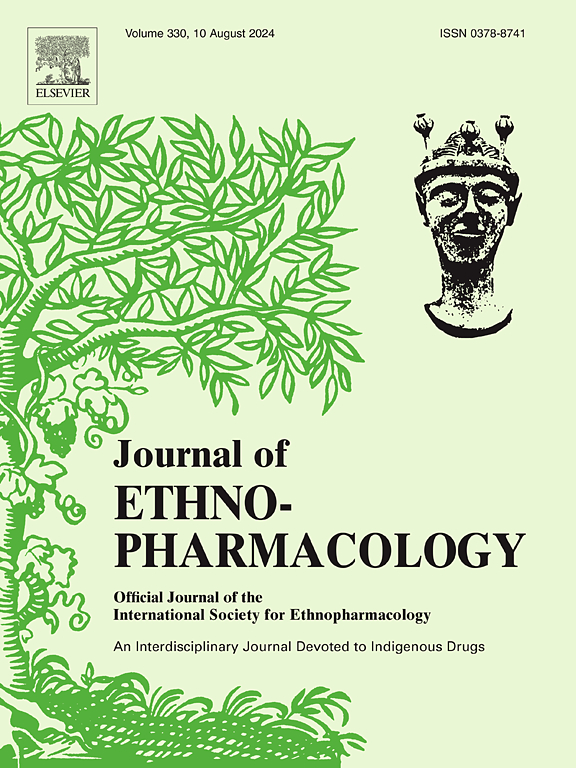Antifungal efficacy of Eugenia uniflora leaves extract: In vitro and in silico investigations against Candida albicans, C. auris and C. glabrata
IF 4.8
2区 医学
Q1 CHEMISTRY, MEDICINAL
引用次数: 0
Abstract
Ethnopharmacological relevance
Eugenia uniflora L. (Myrtaceae), commonly known as pitanga or Brazilian cherry, is widely used in traditional medicine across South America, particularly in Brazil's semi-arid regions, to treat fever, gastrointestinal disorders, and microbial infections. Its therapeutic potential is attributed to phenolic compounds such as myricitrin, gallic acid, and ellagic acid, which exhibit well-documented antimicrobial and anti-inflammatory properties. In the context of the growing global threat posed by multidrug-resistant fungal pathogens, especially species of the Candida genus, exploring natural sources like E. uniflora for antifungal drug development is both timely and necessary.
Aim of the study
Evaluating the antifungal activity of a spray-dried leaf extract of E. uniflora (SDEEu) against Candida spp. (C. albicans, C. glabrata, and C. auris) using in vitro assays and in silico modeling.
Material and methods
The hydroalcoholic extract was spray-dried and subjected to antifungal evaluation. Antifungal activity was initially assessed by determining the minimum inhibitory concentration (MIC) and minimum fungicidal concentration (MFC) against Candida albicans, C. glabrata, and C. auris. To analyze time-dependent inhibitory effects, growth kinetics were monitored. Membrane integrity and morphological alterations were investigated using flow cytometry and scanning electron microscopy. Mechanistic assays included ergosterol-binding and biofilm inhibition analyses. Checkerboard assays were conducted to evaluate synergistic interactions with amphotericin B and nystatin. Finally, molecular docking simulations were performed to assess the binding affinity of major phytochemicals to fungal enzymes involved in membrane and cell wall biosynthesis.
Results
The extract exhibited promising antifungal activity, particularly against C. glabrata and C. auris, with MIC and MFC values of 31.25 μg/mL and 62.50 μg/mL, respectively. The growth curve revealed sustained inhibition over 48 h, particularly during the early metabolic adaptation phase. SDEEu induced predominantly necrotic cell death in all tested strains, while C. glabrata also exhibited apoptotic features, accompanied by marked morphological alterations such as membrane disruption and loss of budding. The extract showed strong interaction with membrane sterols and synergistic effects with amphotericin B and nystatin, notably reversing resistance in C. auris, the most drug-resistant strain, with FICI values as low as 0.022. Furthermore, SDEEu inhibited biofilm formation in all strains, reaching up to 50 % inhibition in C. albicans. In silico docking studies demonstrated strong binding affinities of myricitrin with squalene monooxygenase (−7.8 kcal/mol) and 1,3-β-glucan synthase (−9.0 kcal/mol), supporting a multitarget mechanism of action.
Conclusion
These findings validate the traditional use of Eugenia uniflora in the treatment of infectious diseases and underscore its potential as a natural source of antifungal agents. By combining membrane-targeting effects with multitarget enzymatic inhibition, the spray-dried extract demonstrates a robust antifungal profile. Altogether, SDEEu represents a promising candidate for the development of novel therapeutic strategies against drug-resistant Candida infections.

Eugenia uniflora叶提取物对白色念珠菌、耳念珠菌和光秃念珠菌的体外和室内抑菌效果研究
民族药理学相关eugenia uniflora L.(桃金娘科),俗称pitanga或巴西樱桃,在南美洲的传统医学中被广泛使用,特别是在巴西的半干旱地区,用于治疗发烧、胃肠道疾病和微生物感染。它的治疗潜力归功于酚类化合物,如杨梅三醇、没食子酸和鞣花酸,它们具有充分证明的抗菌和抗炎特性。在多重耐药真菌病原体,特别是念珠菌属物种对全球构成日益严重的威胁的背景下,探索像单胞杆菌这样的天然来源来开发抗真菌药物是及时和必要的。目的:采用体外实验和计算机模拟的方法,评价一种喷雾干燥的uniflora叶提取物(SDEEu)对念珠菌(白色念珠菌、光秃秃念珠菌和金黄色念珠菌)的抗真菌活性。材料与方法采用喷雾干燥法对水醇提取物进行抑菌评价。通过测定对白色念珠菌、光秃念珠菌和耳念珠菌的最低抑菌浓度(MIC)和最低杀真菌浓度(MFC),初步评估了抗真菌活性。为了分析时间依赖性抑制效应,监测了生长动力学。用流式细胞术和扫描电镜观察膜的完整性和形态学改变。机制分析包括麦角甾醇结合和生物膜抑制分析。棋盘试验评估两性霉素B和制霉菌素的协同相互作用。最后,进行了分子对接模拟,以评估主要植物化学物质与参与膜和细胞壁生物合成的真菌酶的结合亲和力。结果该提取物具有较强的抗真菌活性,其中对裸毛念珠菌和耳念珠菌的MIC值为31.25 μg/mL, MFC值为62.50 μg/mL。生长曲线显示持续抑制超过48小时,特别是在早期代谢适应阶段。SDEEu在所有测试菌株中主要诱导坏死细胞死亡,而C. glabrata也表现出凋亡特征,并伴有明显的形态学改变,如膜破坏和出芽丧失。该提取物与膜甾醇具有较强的相互作用,与两性霉素B和制霉菌素具有协同作用,显著逆转了耐药程度最高的金黄色葡萄球菌的耐药性,FICI值低至0.022。此外,SDEEu抑制了所有菌株的生物膜形成,对白色念珠菌的抑制率高达50%。硅对接研究表明,杨梅三醇与角鲨烯单加氧酶(−7.8 kcal/mol)和1,3-β-葡聚糖合成酶(−9.0 kcal/mol)具有很强的结合亲和力,支持多靶点作用机制。结论本研究结果证实了一元Eugenia在感染性疾病治疗中的传统应用,强调了其作为天然抗真菌药物的潜力。通过结合膜靶向效应和多靶点酶抑制,喷雾干燥提取物显示出强大的抗真菌特征。总之,SDEEu代表了开发抗耐药念珠菌感染的新治疗策略的有希望的候选者。
本文章由计算机程序翻译,如有差异,请以英文原文为准。
求助全文
约1分钟内获得全文
求助全文
来源期刊

Journal of ethnopharmacology
医学-全科医学与补充医学
CiteScore
10.30
自引率
5.60%
发文量
967
审稿时长
77 days
期刊介绍:
The Journal of Ethnopharmacology is dedicated to the exchange of information and understandings about people''s use of plants, fungi, animals, microorganisms and minerals and their biological and pharmacological effects based on the principles established through international conventions. Early people confronted with illness and disease, discovered a wealth of useful therapeutic agents in the plant and animal kingdoms. The empirical knowledge of these medicinal substances and their toxic potential was passed on by oral tradition and sometimes recorded in herbals and other texts on materia medica. Many valuable drugs of today (e.g., atropine, ephedrine, tubocurarine, digoxin, reserpine) came into use through the study of indigenous remedies. Chemists continue to use plant-derived drugs (e.g., morphine, taxol, physostigmine, quinidine, emetine) as prototypes in their attempts to develop more effective and less toxic medicinals.
 求助内容:
求助内容: 应助结果提醒方式:
应助结果提醒方式:


